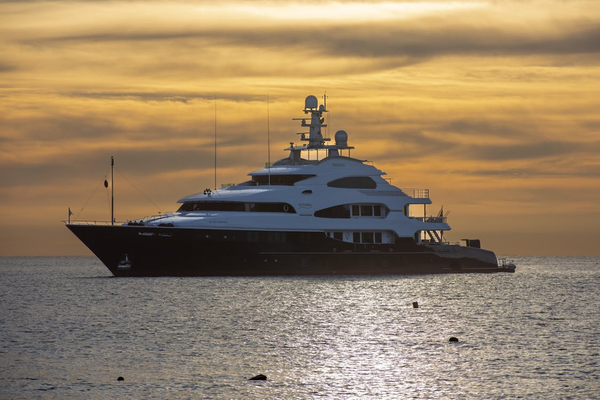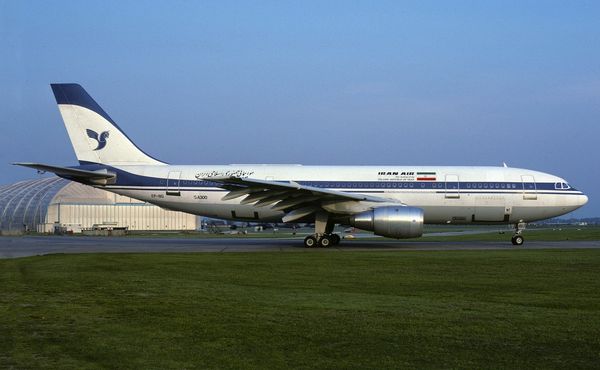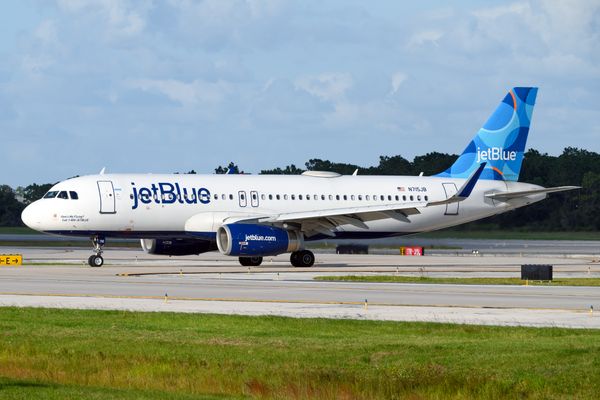The summer morning of June 30, 1956, disaster began with a sudden bang and the sickening crunch of metal crashing into metal. The left wing of a Douglas DC-7 clipped the right-most vertical stabilizer of a Lockheed Constellation 1049-A, then slammed into the fuselage just ahead of the tail assembly.
The propeller of engine number one, the outermost of the two on the DC-7’s left wing, slashed wide gashes into the skin of the other airplane, rupturing the pressure bulkhead and causing a rapid decompression of the passenger cabin.
As the DC-7 fell away to the right, the damaged tail section of the Connie broke away from the rest of the plane, and the airplane began an almost straight-in plunge to the earth, falling 17,000 feet in roughly one minute. The TWA crew likely never knew what had caused their demise.
With the left wing of the Douglas mangled and the outer engine destroyed, the Mainliner began to twist uncontrollably to its left. Magnetic tapes used to record air-to-ground communications for United Airlines caught the last transmission from the stricken DC-7.

“United 718, Ah!” the co-pilot’s voice said. “We’re going in!” In the background, the captain’s frantic voice could be heard exhorting his doomed airplane, “Up! Up! Up!” Nothing more was to be heard from either aircraft again. All 128 passengers and crew onboard the two planes perished, making it the worst air disaster in U.S. history.
Collision Course
In the mid-1950s, traveling on the airlines was still something of a luxury. However, elegant, sophisticated aircraft like the Constellation and the Douglas DC-7, the largest and most advanced airliners, became increasingly common as corporations embraced the convenience of flying their executives from place to place. Well-heeled vacationers also enjoyed the quick flight times and elegant appointments of air travel in the airlines’ “golden age.”
In this environment, two flights began their journeys from Los Angeles International Airport on the morning of June 30, 1956. United Airlines Flight 718 operated in a Douglas DC-7 called “The Mainliner Vancouver.” Captain Bob Shirley, 48, was in command, with over 17,000 hours of flight time. His co-pilot, Robert Harms, 36, was a World War II veteran and former instructor pilot. Gerard Fiore, the flight engineer, rounded out the crew. Two flight attendants served 53 passengers in the cabin.
Trans World Airlines (TWA) Flight 2 to Kansas City was a Lockheed Constellation 1049 named “The Star of Seine.” Jack Grande, 41, captained it. Seventy passengers and crew were on board. The Connie lifted off at 9:01 a.m. PST, and United 718 took off three minutes later.
.jpg)
After being directed out of the Los Angeles area by the local Air Traffic Control facility, the rest of their journeys would transit through uncontrolled airspace. The airliners would report their positions to dispatchers at their respective companies, who would then pass that information on to area air traffic control centers via telephone.
At this time in aviation history, regional controllers did not speak directly to the aircraft. The information was kept on paper records at the controller’s workstation. Nor was there any radar coverage en route. Few airplanes were in the sky, especially at the altitudes where the airliners flow.
Deviations That Brought the Planes Together
The aircraft would report at specific waypoints along their paths. As both planes crossed the American southwest, United 718 was to report first at Palm Springs, then Needles, NV. United 718 was assigned a cruising altitude of 21,000 feet. TWA Flight 2 was given a 19,000-foot cruise and would report at Daggett, then Mojave Lake. The third waypoint for both airliners was the “Painted Desert Line,” an imaginary line stretching almost 200 miles between the VORs at Bryce Canyon, UT, and Winslow, AZ, 335 degrees from true north.
Sometime after reporting at Daggett at 19,000 feet, Capt. Gandy requested that TWA dispatch ask Salt Lake City air traffic control if they could ascent to 21,000 feet to avoid building thunderclouds in their path. This request was denied; however, word was passed back to Capt. Candy that United 718 was at that altitude.
.jpg)
In response, Gandy asked permission to fly “1,000 on top,” a clearance allowing them to fly above and clear of the clouds by at least 1,000 feet. Under 1,000 on top, Visual Flight Rules (VFR) applied. Aircraft operating in the clear air were responsible for “seeing and avoiding” other traffic. When TWA Flight 2 reported at Mohave Lake at 9:59 a.m., they flew at 1,000 on top.
The TWA and United aircraft estimated reaching the Painted Desert Line at 10:31 a.m. However, 20 minutes after the appointed time, United dispatch informed Salt Lake air traffic control that United 718 had yet to report in. Then TWA called to report no response from TWA Flight 2 for their check-in at Painted Desert Line. Local officials on the ground were notified.
Discovery of the Crash Sites
This information reached the ears of Palen Hudgin, a pilot and Grand Canyon air tour operator. Flying earlier in the day, Hudgin had seen smoke rising over the rim of the Grand Canyon. He assumed it was a brushfire set by a lightning strike. But upon hearing of the missing aircraft, he and his brother went up again in their Piper Tri-Pacer to investigate. They returned to the source of the smoke on Chuar Butte and spotted signs of a crash on a rocky ledge 200 meters up the canyon wall.
No more than a mile away on the floor of the Grand Canyon, the Hudgins brothers saw probably one of the most recognizable shapes in commercial aviation: the triple tail of the Constellation. An intense fire raged not more than 500 meters away on the canyon floor near the confluence of the Colorado and Little Colorado Rivers.
.jpg)
Investigators first reached the TWA wreckage on the canyon floor. Later, Rocky Mountain Rescue Club members were enlisted to get to the United wreckage, resting precariously on the ledge on Chuar Butte.
The Investigator and the Investigation
In the days before Cockpit Voice Recorders and Flight Data Recorders, lead accident investigator Jack Parshall had only the physical remains of the two aircraft to go on, and there was very little of either. But the distance of the Constellation’s tail from the rest of the wreckage was an important clue. It led Parshall to believe that the tail had separated from the plane in the air and not as a cause of the impact on the ground.
Further inspection of segments of the fuselage near the tail produced a startling revelation. There was blue paint on the metal. TWA’s airplanes were painted in red and white. Seven hundred meters away, they found a piece of the DC-7 wing with red paint. Parshall concluded that a mid-air collision had occurred. The evidence seemed to show that the DC-7 overran the Connie on the right side.
A Mysterious Question
What was difficult to determine was how both planes had deviated from their original plans sufficiently to put them in the same airspace at the same moment. The airlines suggested that air traffic control was at fault for allowing both aircraft to operate at or near the same altitude.
.jpg)
While Salt Lake City had informed TWA Capt. Gandy of the present of United 718 - and TWA dispatch recorded that Gandy acknowledged that information - no attempt was made to inform Capt. Shirley of the TWA flight. But there was no requirement to do so. Under the procedures of the day, it was understood that it was the responsibility of the pilots to “see and be seen” in uncontrolled airspace and VFR conditions.
However, two other contributing factors that day need to be considered. The first was that the Grand Canyon was a compelling attraction for air tourists, and airlines were eager to provide their passengers with the unforgettable experience of seeing it from the air. Pilots often maneuvered near the canyon to provide such memorable views (even now, most cockpit crews will alert their passengers when approaching the landmark).
The other factor to consider was cloud cover. Capt. Gandy deemed building cumulus clouds in the area enough of a concern to request a higher altitude. Hudgins, the air tour operator, also noted that he first suspected smoke from one of the crash sites was caused by lightning, implying there were also storms in the area.
Jack Parshall determined that in clear conditions, the United crew should have been able to see the TWA Constellation a full 53 miles away, giving them at least two minutes to take evasive action. However, with clouds in the area, aircraft under Visual Flight Rules and in uncontrolled airspace were required to deviate around clouds even if they had risen to their cruising altitude.
.jpg)
In doing so, it was most likely that partial and broken cloud cover obscured direct lines of sight, making it possible that both airplanes appeared suddenly from around cloud formations, leaving insufficient time to maneuver safely away.
In the final Accident Investigation Report published by the Civil Aeronautics Board on Apr. 17, 1957, the board listed the probable cause of the collision as the inability of the cockpit crews to see each other in time to avoid the collision. It listed as possible contributing factors the presence of clouds at their flight level, the preoccupation with providing passengers a scenic view of the Grand Canyon, and the physiological limitations of human vision.
But it also singled out the “… insufficiency of en route air traffic advisory information due to inadequacy of facilities and lack of personnel in air traffic control.”
In its findings, the report did not fault either the crew or the air traffic controllers on duty that day. It did, however, point out the insufficiency of en-route traffic control, stating,
“9. Traffic control services are not provided in the uncontrolled airspace and according to existing Air Traffic Control policies and procedures the Salt Lake controller was not required to issue traffic information; none was issued voluntarily.”
.jpeg)
Sweeping Changes
Both aircraft were following the rules of the time. The overtaking aircraft had the responsibility to avoid the one in front and must give way to the one in front. Unfortunately, this accident showed that “see and avoid” was no longer sufficient, and the deficiencies in ATC of the day did not provide a solution.
Two years later, the collision of another United Airlines DC-7, Flight 736, and an F-100 Super Sabre fighter jet near Las Vegas, Nevada, resulted in 49 fatalities. It was finally time to take action.
The Federal Aviation Act of 1958 officially created the FAA and gave the new agency total control of American civilian and military airspace. Funds were allocated for nationwide radar coverage, allowing aircraft movements to be tracked in even the most remote areas. More ATC personnel were hired, and training increased. More ground-based navigational beacons were created.
With the creation of Class A airspace, VFR flying at high altitudes was no longer allowed. IFR (Instrument Flight Rules) flight plans were required, and direct communication with air traffic controllers was established, replacing the communication system through company dispatchers.
.jpg)
The progress set in motion by the tragic event over the Grand Canyon in 1956 continues today. Increasingly sophisticated Traffic Collision Avoidance Systems (TCAS) designs have become standard onboard even light aircraft. Innovations such as Mode C and ADS-B are revolutionizing the concept of “see and avoid” through GPS-based technology that will play a part in NextGen aerial navigation.
The victims of the collision of TWA Flight 2 and United 718 were buried in mass graves in cemeteries near the Grand Canyon. Markers were set, accessible mostly to hikers. The wreckage was finally cleared decades later, yet bits and pieces reportedly lie on the canyon floor.
But the loss of 128 lives on June 30, 1956, has never been in vain. We owe the modern en route air traffic control system to their sacrifice, a system that has made commercial aviation the safest means of transportation in human history.
Mixed Signals: The Tragic Story of Iran Air Flight 655 » Essential Legal Tips for Tourists Chartering a Yacht in Dubai » My Unexpectedly Cheap Last-Minute Getaway with JetBlue Airlines »
Comments (3)
 William Costner
(With apologies to Eages fans everywhere)…
“Well, I'm a-standing on a corner
In Winslow, Arizona
Such a fine sight to see
It's a “Dougie”, my Lord
Overtaking a “Connie” with 70 onboard,
Slowin' down to take a look at me…”
…And the rest is air traffic control history.
William Costner
(With apologies to Eages fans everywhere)…
“Well, I'm a-standing on a corner
In Winslow, Arizona
Such a fine sight to see
It's a “Dougie”, my Lord
Overtaking a “Connie” with 70 onboard,
Slowin' down to take a look at me…”
…And the rest is air traffic control history.
 zFPWdwPk
20
zFPWdwPk
20
 zFPWdwPk
20
zFPWdwPk
20
Add Your Comment
SHARE
TAGS
STORIES TWA United Airlines Midair Collision Collision Accident ATC Air Traffic Control Arizona History Emergency Incident Safety Trans World AirwaysRECENTLY PUBLISHED
 Essential Legal Tips for Tourists Chartering a Yacht in Dubai
Discover how yacht rentals in Dubai are regulated and learn what every tourist should know about contracts, insurance, and taxes before setting sail.
TRIP REPORTS
READ MORE »
Essential Legal Tips for Tourists Chartering a Yacht in Dubai
Discover how yacht rentals in Dubai are regulated and learn what every tourist should know about contracts, insurance, and taxes before setting sail.
TRIP REPORTS
READ MORE »
 Mixed Signals: The Tragic Story of Iran Air Flight 655
What would have otherwise been a routine passenger flight across the Strait of Hormuz culminated in a heartbreaking tragedy, all because of a costly system misunderstanding by an external party. This is the tragic story of Iran Air Flight 655.
STORIES
READ MORE »
Mixed Signals: The Tragic Story of Iran Air Flight 655
What would have otherwise been a routine passenger flight across the Strait of Hormuz culminated in a heartbreaking tragedy, all because of a costly system misunderstanding by an external party. This is the tragic story of Iran Air Flight 655.
STORIES
READ MORE »
 My Unexpectedly Cheap Last-Minute Getaway with JetBlue Airlines
My name is Daniel Moreno. I live in Tampa, Florida, and I work as a logistics coordinator at a small distribution company. I had to book a JetBlue Airlines flight at the last minute. I was sure the price would be high because that’s usually what happens with late bookings within the United States. But the final cost surprised me — the ticket was much cheaper than I expected.
TRIP REPORTS
READ MORE »
My Unexpectedly Cheap Last-Minute Getaway with JetBlue Airlines
My name is Daniel Moreno. I live in Tampa, Florida, and I work as a logistics coordinator at a small distribution company. I had to book a JetBlue Airlines flight at the last minute. I was sure the price would be high because that’s usually what happens with late bookings within the United States. But the final cost surprised me — the ticket was much cheaper than I expected.
TRIP REPORTS
READ MORE »



